Rottweiler
The Rottweiler (/ˈrɒtwaɪlər/, UK also /-vaɪlər/)[1][2] is a breed of domestic dog, regarded as medium-to-large[3][4] or large.[5][6] The dogs were known in German as Rottweiler Metzgerhund, meaning Rottweil butchers' dogs,[7][8] because their main use was to herd livestock[3] and pull carts laden with butchered meat to market.[7] This continued until the mid-19th century when railways replaced droving. Although still used to herd stock in many parts of the world, Rottweilers are now also used as search and rescue dogs, as guard dogs, and as police dogs.[9]
| Rottweiler | |||||||||||||||||||||||||||||||||
|---|---|---|---|---|---|---|---|---|---|---|---|---|---|---|---|---|---|---|---|---|---|---|---|---|---|---|---|---|---|---|---|---|---|
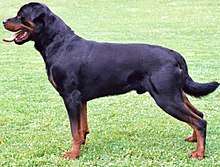 | |||||||||||||||||||||||||||||||||
| Common nicknames |
| ||||||||||||||||||||||||||||||||
| Origin | Germany | ||||||||||||||||||||||||||||||||
| |||||||||||||||||||||||||||||||||
| |||||||||||||||||||||||||||||||||
| Dog (domestic dog) | |||||||||||||||||||||||||||||||||
History
The Rottweiler is one of the oldest of herding breeds.[10] One author supposes that it has a history possibly dating back to the Roman Empire,[11] the Rottweiler may be a descendant of ancient Roman drover dogs, dependable and rugged mastiff-type dogs with great intelligence and guarding instincts. During their quest to conquer Europe, the Roman legions traveled in large numbers across the continent. The lack of refrigeration meant soldiers brought herds of cattle for food. Drover dogs kept the herd together and guarded it at night.[12] Around A.D. 74 the Roman army travelled across the Alps and into what is now southern Germany. For the next two centuries the Roman drover dogs were continually used in herding and driving cattle for trade even after the Romans were driven out of the area by the Swabians.[13][14][15]
The dog breed was subsequently named after Rottweil, a town in the region.[12] It became an important trade center and the descendants of the Roman cattle dogs proved their worth by driving the cattle to market and protecting the cattle from robbers and wild animals.[12] The dogs are said to have been used by traveling butchers at markets during the Middle Ages to guard money pouches tied around their necks.[16] The dogs were eventually known as Rottweiler Metzgerhunds, or "Butchers' Dogs".[17][18][19] As railroads became the primary method for moving stock to market, the demand for the Rottweiler breed declined, as did their numbers, so severely diminished by 1882 that a show in Heilbronn, featured only one very poor representative of the breed.[20]
The buildup to World War I saw a great demand for police dogs, which led to a revival of interest in the Rottweiler. During the First and Second World Wars, Rottweilers saw service in various roles, including as messenger, ambulance, draught, and guard dogs.
The Deutscher Rottweiler-Klub (DRK, German Rottweiler Club), the first Rottweiler club in Germany, was founded on 13 January 1914, and followed by the creation of the Süddeutscher Rottweiler-Klub (SDRK, South German Rottweiler Club) on 27 April 1915 and eventually became the IRK (International Rottweiler Club). The DRK counted around 500 Rottweilers, and the SDRK 3000 Rottweilers. The goals of the two clubs were different. The DRK aimed to produce working dogs and did not emphasise the morphology of the Rottweiler.
The various German Rottweiler Clubs amalgamated to form the Allgemeiner Deutscher Rottweiler Klub (ADRK, General German Rottweiler Club) in 1921. This was officially recorded in the register of clubs and associations at the district court of Stuttgart on 27 January 1924.[21] The ADRK is recognised worldwide as the home club of the Rottweiler.
In 1931 the Rottweiler was officially recognised by the American Kennel Club.[22] In 1936, Rottweilers were exhibited in Britain at Crufts. In 1966, a separate register was opened for the breed. In fact, in the mid-1990s, the popularity of the Rottweiler reached an all-time high with it being the most registered dog by the American Kennel Club.[23] In 2017, the American Kennel Club ranked the Rottweiler as the eighth-most popular pure-breed in the United States.[24]
Technical description
The Fédération Cynologique Internationale gives the following description of the Rottweiler standard: "Rottweiler breeders aim at a dog of abundant strength, black coated with clearly defined rich tan markings, whose powerful appearance does not lack nobility and which is exceptionally well suited to being a companion, service, rescue and working dog."[3] This breed is all about balance, endurance, proportionality, intelligence and strength. The various standards in place for the Rottweiler's physical appearance specify these characteristics.

- Head (eyes)
- Snout (teeth, tongue)
- Dewlap (throat, neck skin)
- Shoulder
- Elbow
- Forefeet
- Highest Point of the Rump
- Legs (thighs and hips)
- Hock
- Hind feet
- Withers
- Stifle
- Paws
- Tail
Head
The skull is of medium length, relatively broad between the ears. The forehead line is moderately arched as seen from the side, with the occipital bone well developed without being conspicuous. The stop is relatively strong. Frontal groove not too deep.
The Rottweiler nose is well developed, more broad than round, with relatively large nostrils and always black. The muzzle should appear neither elongated nor shortened in relation to the cranial region. The ratio between the length of the muzzle and the length of the skull is about 1 to 1.5. The nasal bridge is straight, broad at the base and moderately tapered.
The lips are black and close fitting with the corner of the mouth not visible. The gums should be black, or as dark as possible. Both the upper and lower jaws are strong and broad. According to the FCI Standard Rottweilers should have strong and complete dentition (42 teeth) with scissor bite, the upper incisors closely overlapping the lower incisors. The zygomatic arches should be pronounced (but not exaggerated).
Upper and lower jaw strong and broad. Strong, complete dentition (42 teeth) with scissor bite, the upper incisors overlapping the lower incisors.
The eyes should be of medium size, almond-shaped and dark brown in colour. The eyelids are close fitting and should not droop. The ears are medium-sized, pendant, triangular, wide apart, and set high on the head. With the ears laid forward close to the head, the skull appears to be broadened. The skin on the head is tight fitting overall. When the dog is alert, the forehead may be slightly wrinkled.
Faults:
Hound-type head. Narrow, light too short, long, coarse or excessively molossoid head; excessively broad skull, (lack of stop, too little stop or too strong stop). Very deep frontal groove.
Foreface long, pointed or too short muzzle (any muzzle shorter than 40 percent of the length of the head is too short). split nose; Roman nose (convex nasal bridge) or dish-faced (concave nasal bridge); acquiline nose, pale or spotted nose (butterfly nose).
Pincer bite. Molars of the underjaw not standing in one line.
Severe Faults:
Too molossoid type and heavy general appearance.[3]
Neck
The neck is strong, of fair length, well muscled, slightly arched, clean, free from throatiness, without excessive dewlap.
Body
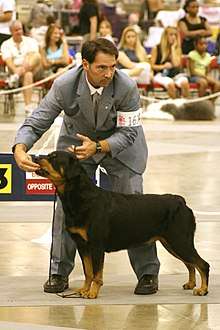
The back is straight, strong and firm. The loins are short, strong and deep. The croup is broad, of medium length, and slightly rounded, neither flat nor falling away. The chest is roomy, broad and deep (approximately 50% of the shoulder height) with a well-developed forechest and well sprung ribs. The flanks are not tucked up.
Tail
The FCI 2018 Standard states:
In natural condition, strong, level in extension of the upper line; while paying attention, when excited or while moving it can be carried upward in a light curve; at ease it may be hanging. While positioned along the leg, the tail reaches approximately to the hocks or is a bit longer.[3]
Historically the tail was traditionally docked at the first or second joint. However, docking is now banned in most countries and this is reflected in the FCI Country of Origin Breed Standard.[3]
Although once "preferred" in early Standards, in 2018 the FCI Standard was amended to classify the Natural Bob Tail (aka "Stumpy") as a "Disqualifying Fault" along with "kink tail, ring-tail, with strong lateral deviation.[3]
Limbs
When seen from the front, the front legs are straight and not placed close to each other. The forearm, seen from the side, stands straight and vertical. The slope of the shoulder blade is about 45 degrees. The shoulders are well laid back. The upper arm is close fitting to the body. The forearm is strongly developed and muscular. Pasterns are slightly springy, strong but not steep. The front feet are round, tight and well arched, the pads hard, nails are short, black and strong.
When seen from behind, the rear legs are straight and not too close together. When standing free, obtuse angles are formed between the dog's upper thigh and the hip bone, the upper thigh and the lower thigh, and the lower thigh and metatarsal. The upper thigh is moderately long, broad and strongly muscled. The lower thigh is long, strongly and broadly muscled, sinewy. The hocks are sturdy, well angulated, not steep. The hind feet are slightly longer than the front feet. Toes are strong, arched, as tight as the front feet.
Gait
According to the FCI Standard:
The Rottweiler is a trotting dog. In movement the back remains firm and relatively stable. Movement harmonious, steady full of energy and unrestricted, with good stride.
However, "sluggish action while trotting" is considered a "Severe Fault".[3]
According to the American Kennel Council the traditional gait of a Rottweiler is a trot. Therefore, the Rottweiler is a trotter. Trotting in this breed is by no means a fault and is required. This movement comes naturally to the Rottweiler and should appear as such; any deviation may lead to a disqualification in the show ring. While walking, the Rottweiler's legs, both front and hind, should move in a straight forward and backward manner. As with the straight movement of the legs, the path the Rottweiler moves in should also be straight. The Rottweiler's gait is all about balance and effectiveness as the breed is still used as a herder today.[25]
Coat
The coat consists of an outer coat and an undercoat. The outer coat is of medium length, coarse, dense and flat. The undercoat should be present on the neck and thighs. The undercoat must not show through the outer coat. Rottweilers living in hot climates may have acclimatised and may be missing the undercoat. Rottweiler coats tend to be low maintenance, although they experience heavy shedding before their seasons (females) or seasonally (males). According to American Kennel Club breed standards, a Rottweiler's coat is short and straight. A coat that is long or wavy is considered a flaw to the AKC.[25]
Color and markings
The color and markings of a Rottweiler are very distinctive. A Rottweiler is always, by any breed club standards, black with well-defined mahogany or rust-colored markings that do not take up more than ten percent of the dog's body color. All Rottweilers standard to AKC specifications have one mahogany dot above each eye on the inner brow ridge, on the cheeks, one strip on each side of the snout; cheek markings do not cross over the bridge of the nose, the top of the nose should remain black. The markings on the face should move down onto the dog's throat. On the chest, a Rottweiler will have two downward-facing triangular marks. On each front leg, the marks will stretch from the forearm to the toes. On the hind legs, the markings will begin on the inside and move outward onto the stifle, then out onto the hock stretching to the toes as well. AKC standards recognize that the black base color is not completely voided on the rear pasterns. There is a patch of rust or mahogany underneath the tail that resembles a triangle as well. A thin strip of black should be present on each of the Rottweiler's toes.[25]
Size
Technically a "medium / large" breed, according to the FCI standard the Rottweiler stands 61–69 cm (24–27 in) at the withers for males, 56–63 cm (22–25 in) for females, and the weight must be between 50 and 60 kg (110 and 132 lbs) for males and 35 and 48 kg (77 and 105 lbs) for females. Weight must be relative to height.
Temperament
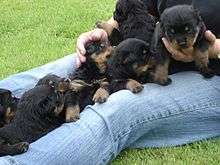
In the breed standard published by Fédération Cynologique Internationale in 2018, the Rottweiler's behaviour/temperament should be:[3]
The Rottweiler is good-natured, placid in basic disposition, very devoted, obedient, biddable and eager to work. His appearance is natural and rustic, his behaviour self-assured, steady and fearless. He reacts to his surroundings with great alertness and at the same time even-tempered.
In the American Kennel Club's "Official Standard of the Rottweiler," the Rottweiler's temperament should be:[25]
a calm, confident and courageous dog with a self-assured aloofness that does not lend itself to immediate and indiscriminate friendships. A Rottweiler is self-confident and responds quietly and with a wait-and-see attitude to influences in its environment. It has an inherent desire to protect home and family, and is an intelligent dog of extreme hardness and adaptability with a strong willingness to work, making them especially suited as a companion, guardian and general all-purpose dog.
According to the American Rottweiler Club:[26]
For us, Rottweilers are the best breed in the world, but we firmly believe they are not a dog for everyone. Rottweilers require a calm, stable and firm “pack leader” or they will assume that role for you. Puppies AND adults need socialization, exercise and stimulating mental challenges. With these things, you will have a wonderful companion; without them, your Rottweiler may become destructive and out of control.
Rottweilers are a powerful breed with well-developed genetic herding and guarding instincts. Potentially dangerous behaviour in Rottweilers usually results from irresponsible ownership, abuse, neglect, or lack of socialisation and training. However, the exceptional strength of the Rottweiler is an additional risk factor not to be neglected. It is for this reason that breed experts declare that formal training and extensive socialisation are essential for all Rottweilers. According to the AKC, Rottweilers love their owners and may behave in a clownish manner toward family and friends, but they are also protective of their territory and do not welcome strangers until properly introduced. Obedience training and socialization are required.[25]
One study published in 2008 found that male Rottweilers have higher confidence, sharpness, and defense and play drives than females.[27]
A 2008 study surveying breed club members found that while Rottweilers were average in aggressiveness (bites or bite attempts) towards owners and other dogs, it indicated they tend to be more aggressive than average toward strangers. This aggression appears correlated with watchdog and territorial instincts.[28]
In the Rottweiler Handbook, Joan H. Walker states that "The Rottweiler is very territorial", meaning that the owner will have to regularly work with the dog to control its territorial aggressiveness.[29]
Working style
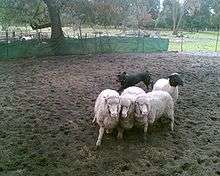
According to the American Kennel Club,[30] Rottweilers have a natural gathering style with a strong desire to control. They generally show a loose eye and have a great amount of force while working well off the stock. They make much use of their ability to intimidate.
The Rottweiler often carries the head on an even plane with the back, or carries the head up but with the neck and shoulders lowered. Some females lower the entire front end slightly when using their eyes. Males also do this when working far off the stock in an open field. This is rarely seen in males when working in confined spaces such as stock yards.
The Rottweiler has a reasonably good natural balance, force-barks when necessary, and when working cattle uses a very intimidating charge. There is a natural change in forcefulness when herding sheep. When working cattle, it may use its body and shoulders and for this reason should be used on horned stock with caution.
The Rottweiler, when working cattle, searches out the dominant animal and challenges it. Upon proving its control over that animal it settles back and tends to its work.
Some growers have found that Rottweilers are especially suited to move stubborn stock that simply ignore Border Collies, Kelpies, and others. Rottweilers use their bodies to physically force the stubborn animal to do its bidding if necessary.
When working with sheep, the Rottweiler shows a gathering/fetching style and reams directions easily. It drives sheep with ease.
In some cases, Rottweilers have begun herding cattle without any experience at all.
If worked on the same stock for any length of time, the Rottweiler tends to develop a bond with the stock and will become quite affectionate with them as long as they do as it directs.[31]
The Rottweiler is also exceptionally suited for and is commonly used in many dog sports including Agility and Schutzhund.
Health

Rottweilers are a relatively healthy, disease-free breed. As with most large breeds, hip dysplasia can be a problem. For this reason the various Rottweiler breed clubs have had x-ray testing regimens in place for many years. Osteochondritis dissecans, a condition affecting the shoulder joints, can also be a problem due to the breed's rapid growth rate. A reputable breeder will have the hips and elbows of all breeding stock x-rayed and read by a recognised specialist, and will have paperwork to prove it.
They will also have certificates that their breeding animals do not have entropion or ectropion and that they have full and complete dentition with a scissor bite.
As with any breed, hereditary conditions occur in some lines. The Rottweiler is very prone to osteosarcoma which is among the most common causes of early death in Rottweilers. For unknown reasons, Rottweilers are more susceptible than other breeds to become infected with parvovirus, a highly contagious and deadly disease of puppies and young dogs.
If overfed or under-exercised, Rottweilers are prone to obesity. Some of the consequences of obesity can be very serious, including arthritis, breathing difficulties, diabetes, heart failure, reproductive problems, skin disease, reduced resistance to disease and overheating caused by the thick jacket of fat under the skin.[32]
Breed surveys in the US, UK and Denmark, and UK vet data puts the average lifespan of Rottweilers at 8 to 10 years.[33][34]
As with the vast majority of large-breed dogs, Rottweilers are also predisposed to dilated cardiomyopathy.
Media portrayal
The portrayal of Rottweilers as vicious or malevolently aggressive dogs in several fictional films and TV series, most notably in The Omen, along with sensationalist press coverage, has created a negative image of the breed.[35][36][7][37][38] In the UK, Rottweilers are widely perceived as status dogs – potentially dangerous or aggressive dogs kept to intimidate others, and possibly as weapons.[39] A few countries such as Ireland, Portugal, Romania, Malaysia, and Singapore place restrictions on the ownership of Rottweilers. Rottweilers are banned as pets in Ecuador.[40]
Some films and television shows, such as Lethal Weapon 3, the 1998 film Half Baked, and the hit HBO show Entourage, have portrayed Rottweilers in a positive light. They are also featured in the children's book series Good Dog, Carl by Alexandra Day.[41]
In an event widely reported by the media, a two-year-old UK Rottweiler named Jake owned by Liz Maxted-Bluck was recognised for his bravery by the RSPCA. The dog was out walking with his owner when they heard screams. Jake chased off a man as he molested a woman on Hearsall Common, Coventry, in July 2009. He located the attacker and his victim in thick scrub, chased off the attacker, led his owner to the scene, then stood guard over the victim until police arrived. The attacker was convicted of serious sexual assault and jailed for four years. Jake was nominated by police for the bravery award and medallion after the incident. Det Con Clive Leftwich, from Coventry police station, said: "From our point of view Jake the Rottweiler stopped a serious sexual assault from becoming even worse."[42]
Gallery
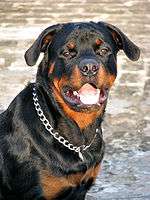 One-year-old Rottweiler
One-year-old Rottweiler.jpg) Male Rottweiler
Male Rottweiler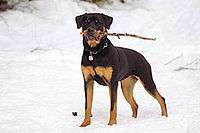 Female Rottweiler
Female Rottweiler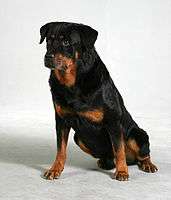 10-year-old Rottweiler
10-year-old Rottweiler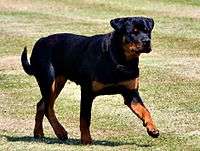 Rottweiler
Rottweiler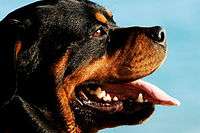 A close-up headshot
A close-up headshot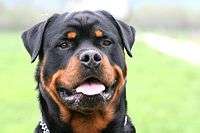 Headshot of a Rottweiler
Headshot of a Rottweiler An oblique head shot
An oblique head shot
References
- "Oxford Dictionaries". Retrieved 18 July 2016.
- "Oxford Dictionaries-US". Retrieved 29 September 2016.
- "Rottweiler breed standard" (PDF). FCI. Retrieved 7 April 2019.
- "Rottweiler". Australian National Kennel Council. Retrieved 28 February 2016.
- "Rottweiler". The Kennel Club. Retrieved 28 February 2016.
- "Rottweiler". New Zealand Kennel Club. Retrieved 28 February 2016.
- Chun, Rene (14 August 1994). "THING; Have You Hugged Your Rottweiler Today?". Retrieved 1 May 2019 – via NYTimes.com.
- "rottweiler". Purina. Retrieved 1 May 2019.
- Adolf Pienkoss, The Rottweiler, 3rd ed., Borken, Germany: Internationale Föderation der Rottweilerfreunde, 2008.
- Manfred Schanzle, Studies in The Breed History of The Rottweiler. DVM thesis, University of Munich, 1969.
- American Kennel Club (2006). The Complete Dog Book. 3 (20 ed.). New York: Ballantine Books. ISBN 978-0-307-41699-5. Retrieved 13 March 2012.
The origin of the Rottweiler is not a documented record. Once this is recognized, actual history tempered by reasonable supposition indicates the likelihood he is descended from one of the drover dogs indigenous to ancient Rome.
- "Rottweiler: History". American Kennel Club. Retrieved 7 April 2019.
- Biniok, Janice (9 May 2019). Our Best Friends: Rottweiler, The. Eldorado Ink. ISBN 9781932904727 – via Google Books.
- Lavigne, Guillaume de (18 March 2015). The Draft Dog - Past and Present. Lulu Press, Inc. ISBN 9781326218447 – via Google Books.
- "Postcard From Germany: Rottweil Revels". The Bark.
- "Rottweiler". Encyclopædia Britannica. Retrieved 14 March 2012.
- Beauchamp, Richard G. (4 May 2011). Rottweilers For Dummies. John Wiley & Sons. ISBN 9781118069349 – via Google Books.
- 999 and other working dogs. WSN (Maps and Plans). ISBN 9781858290645 – via Google Books.
- "Weekend Wanderlust: 'Fasnet' and foolhardiness in Rottweil". www.thelocal.de. 1 March 2019.
- Lavigne, Guillaume de (18 March 2015). The Draft Dog - Past and Present. Lulu Press, Inc. ISBN 9781326218447 – via Google Books.
- Pienkoss, 2008.
- "Get to Know the Rottweiler", 'The American Kennel Club', Retrieved 29 May 2014
- Thomas G. VanSach. "The History of the Rottweiler". vansach.com. Archived from the original on 31 March 2012.
- "Most Popular Dog Breeds – Full Ranking List". The American Kennel Club. Retrieved 7 April 2019.
- "AKC Official Standard of the Rottweiler" (PDF). Retrieved 7 April 2019.
- "About the Rottweiler - Thinking About Owning A Rottweiler?". American Rottweiler Club.
- Liimatainen, R.; Liinamo, A.-E.; Ojala, M. (July 2008). "Genetic and environmental factors affecting behavior test results in Rottweilers". Journal of Veterinary Behavior: Clinical Applications and Research. 3 (4): 178. doi:10.1016/j.jveb.2007.11.006. ISSN 1558-7878.
- Duffy, Deborah L.; Hsu, Yuying; Serpell, James A. (2008). "Breed differences in canine aggression". Applied Animal Behaviour Science. 114 (3–4): 441–460. doi:10.1016/j.applanim.2008.04.006.
- "The Rottweiler". Modern Dog magazine. Retrieved 1 May 2018.
- American Kennel Club, AKC Herding Regulations
- "Breed Feature: Bernese Mountain Dogs, Leonbergers & Rottweilers", National Dog – The Ringleader Way, vol. 12, nos. 1&2 (Jan/Feb 2009), p. 12.
- Les Price, Rottweilers: An Owner's Companion. New York: Macmillan,1991, p. 114.
- Cassidy, Kelly M. "Breed Longevity Data". Retrieved 25 June 2012.
- O’Neill, D. G.; Church, D. B.; McGreevy, P. D.; Thomson, P. C.; Brodbelt, D. C. (2013). "Longevity and mortality of owned dogs in England" (PDF). The Veterinary Journal. 198 (3): 638–43. doi:10.1016/j.tvjl.2013.09.020. PMID 24206631. "n=105 median=8.0 IQR=5.5–10.2"
- Knight-Ridder/Tribune, Deborah Lawson (20 September 1992). "PET OR LETHAL WEAPON?". chicagotribune.com.
- "Rottweilers can be friends, therapy dogs, too". old.post-gazette.com.
- "ROTTWEILERS". Washington Post. Retrieved 3 December 2018.
- "Rottweiler sinks its teeth into crime". www.scotsman.com. Retrieved 8 May 2019.
- Iqbal, Nomia (21 May 2009). "Dangerous 'status' dogs on the rise". BBC Radio 1 Newsbeat. BBC. Retrieved 21 July 2018.
- "Ecuador prohíbe tener como mascotas a perros de razas Pitbull y Rottweiler" [Ecuador prohibits ownership of Pitbull and Rottweiler dogs as pets]. La Hora (in Spanish). 4 February 2009. Retrieved 16 January 2018.
- "Alexandra Days' Carl". EW.com.
- "Rottweiler honoured for stopping Coventry sex attacker". BBC News. 26 September 2010. Retrieved 1 October 2010.
Further reading
- Blackmore, Joan. A Dog Owner's Guide to the Rottweiler
- Brace, Andrew H. (Ed), The Ultimate Rottweiler, Ringpress Books, Surrey, 2003. ISBN 1-86054-263-8
- Coren, Stanley. The Intelligence of Dogs, University of British Columbia, Vancouver. (1994).
- Chardets: Know your Rottweiler
- Fédération Cynologique Internationale-Standard N° 147/ 19. 06. 2000 / GB The Rottweiler. Translated by – Mrs C. Seidler Country of Origin – Germany.
- Kaneene, JB, Mostosky UV, Miller R. "Update of a retrospective cohort study of changes in hip joint phenotype of dogs evaluated by the OFA in the United States, 1989–2003", Vet Surg 2009;38:398–405, Interscience.wiley.com, abstract
- '"National Dog – The Ringleader Way, Volume 12 Number 1 & 2, Jan/Feb 2009 Breed Feature "Bernese Mountain Dogs, Leonbergers & Rottweilers".
- Pettengell, Jim. The Rottweiler
- Pienkoss, Adolf. The Rottweiler, 3rd revised and updated edition, Internationale Foederation der Rottweilerfreunde (IFR) Wilhelmitenstr. 15a, 46354 Borken, Germany, 2008
- Price, Les. Rottweilers: an owner's companion. Macmillan Publishing Company, New York 1991. ISBN 0-87605-297-9
- Schanzle, Manfred, Studies In The Breed History Of The Rottweiler. German edition Published by Allgemeiner Deutscher Rottweiller – Klub (ADRK) E.V. 1967 English edition published jointly by Colonial Rottweiler Club & Medallion Rottweiler Club – Sept 1969. 1981 Printing (updated) – Published by Powderhorn Press 3320 Wonderview Plaza, Hollywood, CA90068.
- Yrjola, J.A.U. & Tikka, Elvi. Our Friend the Rottweiler